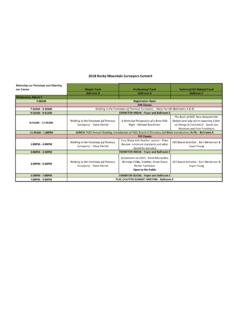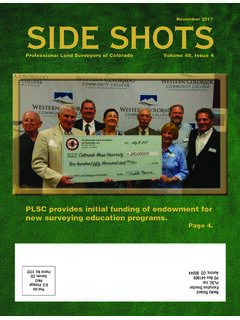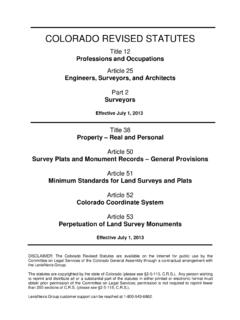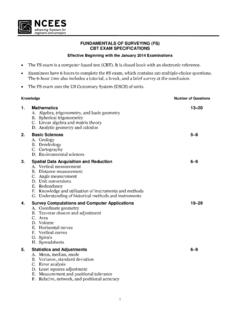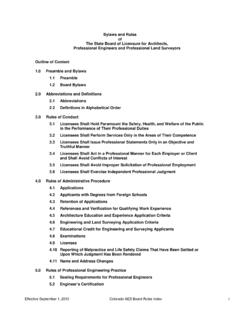Transcription of THE SURVEYOR IN BOUNDARY DISPUTE LITIGATION
1 THE SURVEYOR IN BOUNDARY DISPUTE LITIGATION Copyright 2016 by David W. Pehr 1 Trial Preparation and Discovery Mandatory disclosures. As an expert witness, your opinions and the facts upon which they are based, as well as your reports, are subject to mandatory disclosure under Rule 26(a)(2) of the Colorado Rules of Civil Procedure, which requires that each side voluntarily provide certain information to the other side by a particular date. The penalty for non-compliance, in the case of an expert, is to preclude the expert from testifying. The dates for these disclosures vary from district to district, from judge to judge, and even from case to case.
2 However, they are always due at least 120 days before trial. Surveyors should always keep these disclosure limits in mind when performing the survey and preparing the report and exhibits. In order to comply with these disclosure requirements, the following must be disclosed: 1) The identity of the expert, including his name, address and telephone number. 2) A statement of all opinions he is to express at trial. 3) The basis and reasons for each such opinion. 4) The data and information considered in forming each opinion. 5) A list and copies of all exhibits prepared by the expert for use at trial. 6) A list and copies of all exhibits or considered by the expert in forming his opinion.
3 7) A statement of the expert s qualifications, including: a) All publications authored in the last 10 years. b) The charge for the investigation. 2 c) The payment for testifying. d) All cases in which the he has testified at trial in the past four years. e) All cases in which he has testified at deposition in the last four years. This must presented to both the Court and the opposing counsel at least 120 days before trial. A good trial attorney will make sure the SURVEYOR understands the deadlines and their importance before giving the SURVEYOR the commission. Even more importantly, the SURVEYOR who is used to testifying as an expert will himself be aware of these disclosure requirements and will inquire as to the relevant dates at the very onset of his commission.
4 All such inquiries to the attorney should be made in writing. As a expert, the SURVEYOR should be prepared to deliver the required information in a timely fashion. To aid in this endeavor, the SURVEYOR should consider keeping an up to date resume, or curriculum vitae, on hand as a computer file. This should include the following: 1) A list of all publications authored in the last 10 years. 2) A list of all cases in which he has testified at trial in the past four years. 3) A list of all cases in which he has testified at deposition in the last four years. 4) A summary of his educational background, beginning at high school 5) A list of all professional courses and workshops he has attended.
5 6) A list of states in which he holds a professional license and the license numbers. 7) A list of all professional courses or seminars he has taught. 3 8) A list of all professional societies to which he belongs. 9) A list of all offices he has held in any such professional societies. 10) Cases in which he served as a commissioner with the case number and court name. 11) Whether he has been an investigator or mentor for the Board of Registration. 12) His employment history in the field of land surveying. 13) His ownership of any land surveying businesses, either past or present. The Report. Typically, surveyors want to use the land survey plat of their work as their report.
6 However, this is really insufficient to satisfy the requirements of Rule 26(a)(2) and is also inadequate to properly inform attorney in the preparation of his case. A good report can also assist the attorney in settling the case before trial. Finally, it is a valuable tool to prepare the SURVEYOR himself for his appearance in court. I recommend the following format for the SURVEYOR s report: REPORT OF PLAINTIFF S EXPERT, HARLEY DAVIDSON Harley Davidson, having been retained by Plaintiff as an expert land SURVEYOR , now submits the within Report. I COMMISSION The undersigned was retained by Plaintiff to perform all necessary studies and investigations and to render an opinion as to whether the location of the easement described in that certain Notice of Claim of Easement attached as Exhibit A.
7 II PROCEDURES In conducting the study and investigation necessary to arrive at the conclusions herein stated, I first examined the documents set forth in Section III. I then viewed the property described in Exhibit A on May 19, 2015, and examined the subject ditch. At that time, I also observed both 26th Avenue and Colorado Highway No. 17 in the vicinity of the property. Next, I conducted a field survey as described in Section V, below. I then reviewed Colorado case law concerning the establishment and location of easements, including those cases listed in subsection III(2) of this report.
8 4 (This section should contain a description, not necessarily brief, of the procedures which the expert followed in conducting his investigation, including any documents or records he examined, any monument records or field notes he obtained, the nature and purpose of any field work and a description of any problems or ambiguities he encountered.) III DATA CONSIDERED In forming the opinions set forth herein I relied upon the following data: 1. The following documents were reviewed: a. Plaintiffs Complaint. b. Defendants Answer and Counterclaim. c. Response to Plaintiffs Request for Admissions. d. Brief in Support of Motion for Summary Judgment.
9 E. Response to Motion for Summary Judgment. f. Reply in Support of Motion for Summary Judgment. g. Reporter s transcript of hearing had on January 21, 2014. h. The preliminary plat of Pukin Patch Farms. i. All monument records relating to the Northwest corner of Section 30, T4S, R68W of the 6th PM. j. All monument records relating to the West quarter corner of Sec 30, T4S, R68W of the 6th PM. k. Aerial photos of the above quarter Section dated 1929. l. Aerial photos of the above quarter Section dated 1972. m. Copies of the original notes of the BLM survey of the above Section dated 1860.
10 2. The following Colorado Court decisions were reviewed: a. Ericksen v Whitescarver, 142 P. 413 (Colo. 1914) b. White v Evans, 208 922 (Colo. 1949) c. Moddelmog v Cook, 330 1113 (Colo. 1958) d. Sullivan v Transamerica, 2 56 (Colo 1975) 3. I spoke to the following witnesses at the time of the survey: 5 a. Gregory Peck, 7880 Umatilla St. Westminster, CO 80621, telephone # 807-262 4756, who told me he knew where the original corner stone for the West quarter corner was located but was never going to tell me and threw me off his property. b. Jerry Seinfeld, 7890 Umatilla St. Westminster, CO 80621, telephone # 807-262 7890, who told me he worked on the survey crew that slope staked the Rocky Mountains for God and knew exactly where the quarter was located, but couldn t remember right then.
